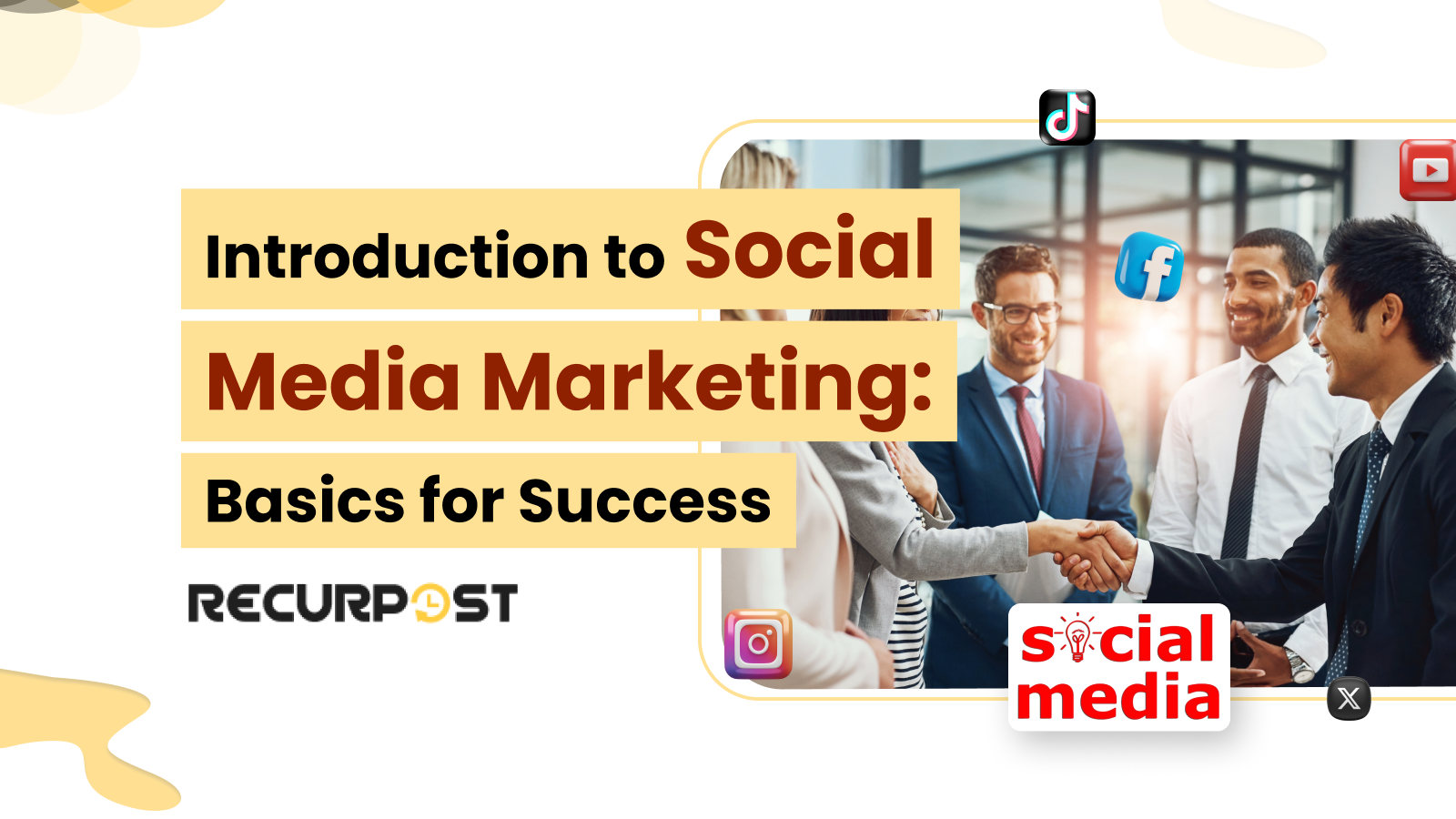“Is it too late to start social media marketing in 2025?” No. Here’s why.
Not even close. And here’s why.
Social media is a digital ecosystem of interconnected platforms and networks that functions as a marketing platform where over 5.4 billion people actively engage globally, representing more than two-thirds of the world’s population who interact with brands and content daily through posts, comments, shares, and direct messages.
Most users hop across 6–7 platforms daily, spending an average of 2.5 hours engaging with posts, videos, stories, and messages. If your brand isn’t part of those conversations, chances are, your competitors are. Social media marketing (SMM) builds trust, connects brands with people, and drives results without massive budgets or fancy equipment. And no, you’re not too late.
The tools are smarter, the data is clearer, and creators are growing audiences with just a smartphone and a bit of consistency. Social media marketing is the strategic use of platforms like Instagram, TikTok, LinkedIn, and others to grow your brand, build meaningful relationships, and convert attention into business outcomes through posts, carousels, DMs, and comments.
Social media marketing basics for beginners include platform selection, content creation, audience engagement, and performance tracking as the core elements that newcomers must master to build successful campaigns, making this beginner’s guide perfect for you if…
- You’re launching a new brand and feel stuck on where to begin
- You’re a small business owner struggling to get noticed
- You’re managing social pages but don’t fully “get it” yet
Social Media Marketing 101 covers foundational elements that we’ll examine in this guide, including:
- What SMM is (no jargon, just real talk)
- How is it different from social media management or traditional ads
- Where platforms are heading in 2025 (hint: AI is your best teammate)
- Step-by-step tips to create your own SMM plan
- Common mistakes to avoid
- Smart tools to save time and reduce overwhelm
- Big trends shaping the future of social marketing
You don’t need a team. You don’t need a $10000 ad budget: just this blog, a Wi-Fi connection, and a bit of consistency.
What Is Social Media Marketing (SMM)?
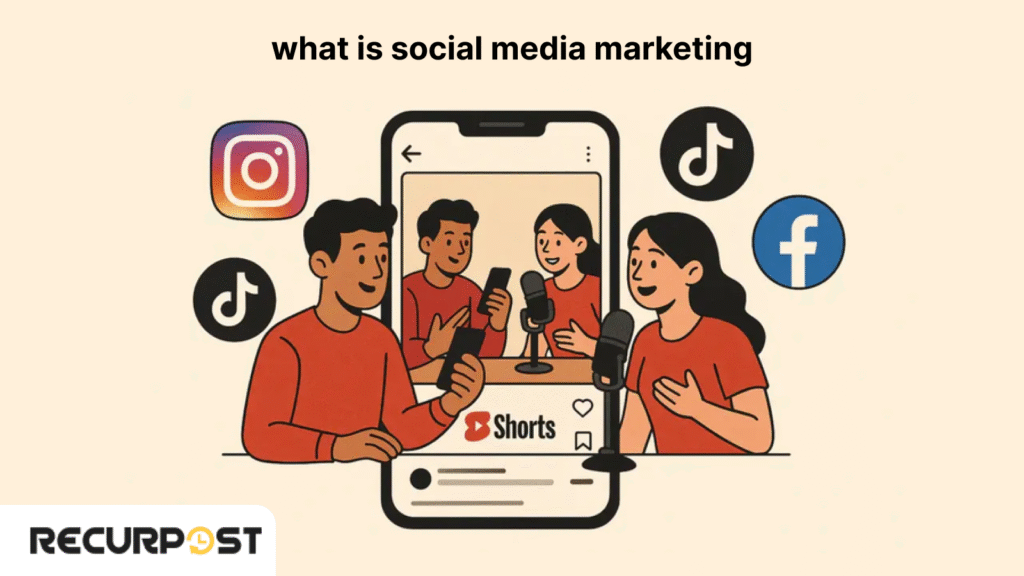
A local bakery posting short videos of freshly frosted cupcakes doubled walk-ins within a month, demonstrating effective social media marketing.
Social media marketing is the strategic use of platforms like Instagram, TikTok, LinkedIn, and others to grow your brand, build meaningful relationships, and convert attention into business outcomes through posts, carousels, DMs, and comments.
Which works by using content such as reels, polls, carousels, and behind-the-scenes stories to educate, engage, and connect with your audience while aligning with your business goals, rather than flooding your feed with selfies or chasing trending hashtags.
Need post ideas that work in 2025? Check out our 35 Instagram Post ideas to start creating content your audience wants to see.
What’s the purpose behind all this effort?
Social media marketing operates on fundamental concepts and principles that generate awareness, spark engagement, earn trust, and eventually convert followers into paying customers or loyal fans through strategic content distribution and audience interaction, which form the foundation that guides all successful social media campaigns and content creation decisions.
However, many people often confuse social media marketing with social media management. Here’s a quick breakdown:
Social Media Marketing vs. Social Media Management
Marketing
The strategy: builds campaigns, crafts messages, and drives goals like traffic or conversions – the “why” behind social media.
Management
The execution: posts content, replies to engagement, updates bios, and analyzes performance – the “how” of social media.
Example:
A social media marketer creates a reel campaign (Social Media Campaign) about “Cupcake Fridays” on social networking sites.
A social media manager is replying to comments, sharing reviews, and resharing customers’ reactions.
Ready to launch your campaign?
Grab our free Social Media Campaign Template to plan, organize, and execute high-impact campaigns without the overwhelm.
Social media campaign management is the strategic process of organizing, launching, and tracking focused content initiatives that work toward specific business objectives over a defined period. This differs from everyday social posting because campaigns operate through distinct stages:
- strategy development (setting clear goals and identifying your target audience)
- content development (creating cohesive, themed materials)
- launch phase (distributing content across selected channels)
- performance assessment (analyzing results against your initial targets).
Effective campaign workflows center around content batching—producing multiple campaign-related posts in concentrated work sessions—then strategically scheduling this content across your platforms while actively tracking daily performance metrics during live campaigns. New marketers should begin with manageable campaigns such as a 7-day product showcase or a 4-week educational content series.
The foundation of strong campaign management rests on maintaining unified messaging throughout all campaign touchpoints, incorporating compelling calls-to-action in every post, and continuously monitoring metrics to optimize performance in real-time. Platforms like RecurPost simplify campaign execution by enabling advanced content scheduling and providing comprehensive engagement tracking throughout your entire campaign lifecycle.
Traditional Marketing vs. Social Media Advertising
Let’s break down why social media is overtaking old-school methods in every category.
| Feature | Traditional Marketing | Social Media Advertising |
| Budget | ₹50,000+ for print/radio ads | ₹700+ for a boosted Instagram post |
| Targeting | Broad, generic audiences | Pinpoint by age, interests, and location |
Speed | Days or weeks to launch | Instant, real-time updates |
| Feedback | Post-campaign analysis | Live insights, comments, DMs |
| Content | Static (flyers, billboards) | Dynamic (videos, reels, stories) |
| Engagement | One-way communication | Two-way, interactive conversations |
| Tracking | Rough estimates | Exact metrics (reach, clicks, shares) |
Did You Know?
- 63.9% of the world’s population is active on social media as of 2025. (Smart insight)
- Social media ad spend has grown by 14.5% this year, crossing $270 billion (Statista).
- 83% of marketers say social media brings in more qualified leads than traditional methods (HubSpot x Meltwater).
- Brands without a social presence miss out on 45% of first-time inquiries (Meta, 2025).
Why You Need a Tailored Social Media Marketing Strategy in 2025
What Social Media Marketing Services Include
Social media marketing services cover a comprehensive suite of activities focused on strengthening your brand’s digital presence and generating measurable business outcomes across social platforms.
Core Service Components
Content Strategy & Creation: Professional providers craft detailed content calendars, develop engaging captions, create custom graphics, and produce compelling videos that reflect your brand personality while supporting your business objectives. This spans routine daily content through specialized campaign materials.
Platform Management: Services oversee publishing schedules, handle community engagement, manage comment responses and direct messages, and ensure consistent brand representation across all selected platforms. This comprehensive management keeps your audience connected while allowing you to focus on other business priorities.
Paid Advertising Management: Most services incorporate social media ad development, audience targeting, budget allocation, and performance optimization. Coverage extends from simple post promotions to sophisticated marketing funnels engineered to capture leads or drive conversions.
Analytics & Reporting: Professional providers monitor key performance indicators, study audience engagement patterns, and deliver detailed reports highlighting successful tactics and improvement opportunities. This metrics-focused methodology enables continuous strategy refinement.
Strategy Development: Services typically launch with comprehensive audits of your existing social presence, in-depth target audience research, competitive landscape analysis, and development of tailored strategies that support your specific business goals and available resources.
What to Expect from Professional Services
Reputable social media marketing services deliver quantifiable outcomes, including enhanced engagement rates, audience growth, increased website traffic, and improved lead generation.
Standard offerings include monthly performance summaries, periodic strategy consultations, and continuous optimization driven by real-time data insights.
Service packages vary from foundational content creation and scheduling to full-scale management encompassing strategy development, content production, advertising campaigns, and comprehensive analytics.
Select services aligned with your immediate requirements and long-term growth aspirations, whether you’re establishing your initial social presence or expanding an established platform.
Why Strategy Is Essential Right Now
In today’s digital space:
- People decide in seconds whether to stop scrolling
- Social platforms keep evolving at breakneck speed
- Traditional advertising is too expensive and too slow to keep up
- Audiences crave realness, not rehearsed or “salesy” content
This is where a strategy helps.
Social media marketing best practices are proven methods and techniques that help you:
- Choose the right platforms based on your goals and audience
- Stay consistent across formats and channels
- Create content people want to engage with
- Use tools to save time and maintain quality
- Track results using real metrics like reach, engagement, and conversions
Strategy Beats Spontaneity (Every Time)
Sure, spontaneous posts can go viral once in a while. But relying on luck isn’t sustainable.
A social media marketing strategy helps you:
- Set clear goals like building awareness, generating leads, or improving engagement
- Pick the right social media channels and networks for your niche
- Plan your content around what your audience needs, not just what’s trending
- Use scheduling and automation tools to stay visible without burning out
When your efforts are aligned with a bigger plan, you stop guessing and start growing.
7-Step Blueprint to Build Your Social Media Marketing Strategy (From Scratch)
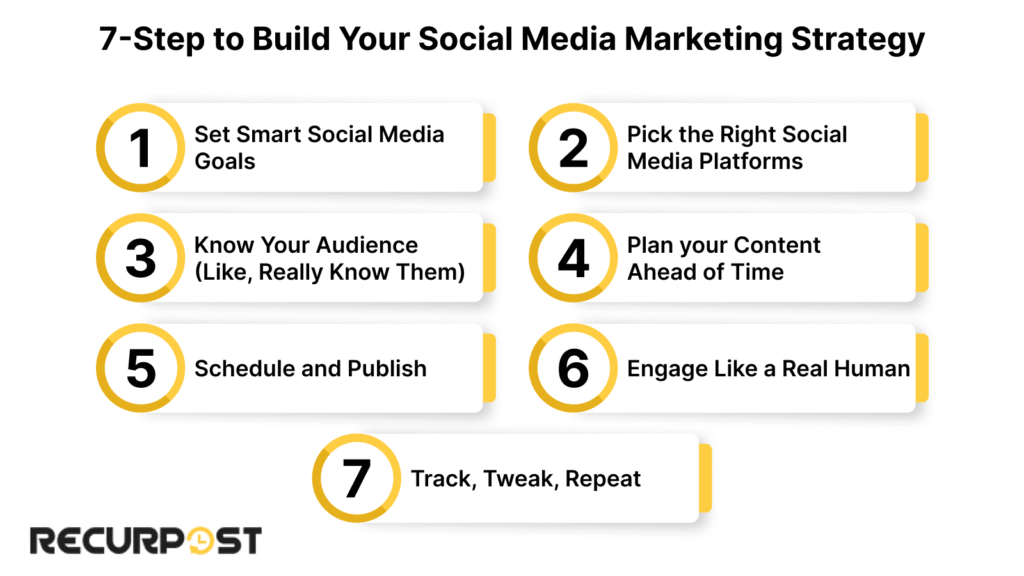
Building a successful social media strategy requires a repeatable plan you can tweak, track, and trust.
Here’s how to take all that theory and turn it into a working strategy.
Step 1: Set Smart Social Media Marketing Goals
Start with goals. Posting without goals lacks direction.
Define success through clear, trackable outcomes like:
- Get 1,000 followers on Instagram in 3 months
- Book 10 client calls from LinkedIn posts
- Generate 50 email signups through Facebook ads
Use the SMART method:
Specific, Measurable, Achievable, Relevant, Time-bound.
These goals are the base of your entire social media marketing plan.
Step 2: Pick the Right Social Media Platforms
Choose social media platforms that match your audience and product.
Consider:
- Audience behavior shifts
- Platform strengths
- Where your content style fits best
| If your audience is… | Try these platforms |
| Gen Z, creators | TikTok, Instagram |
| Working professionals | LinkedIn, YouTube |
| Local shoppers | Facebook, Instagram |
| Visual-first buyers | Instagram, Pinterest |
Pick two platforms max to start. You can always expand later.
Step 3: Know Your Audience (Like, Really Know Them)
Content succeeds when it speaks to real people.
Use tools like:
- Meta Audience Insights for Facebook and Instagram
- LinkedIn Analytics to see who’s engaging
- Google Analytics for behavior data
- RecurPost to track what content gets the most engagement
Look for data on:
- Age, gender, and location
- When they’re online
- What posts do they engage with
- What kind of content do they share
No guessing. Social media insights tell you what to post, when to post, and who you’re talking to.
Read >> To Learn [How to attract a suitable audience]
Step 4: Plan Your Content Ahead of Time
Planning prevents daily “What should I post today?” burnout.
Build a simple social media content calendar that includes:
- Weekly themes (education, social proof, product)
- Post types (carousel, video, poll, Story)
- Captions and hashtags
- Posting schedule for each platform
Batch content creation weekly or monthly. Use Canva for visuals and Notion or Google Docs for planning.
Bonus: RecurPost helps recycle evergreen content, so your best posts continue to work for you.
Step 5: Schedule and Publish
Automate posting with social media management platforms.
Use a social media management platform like:
- Schedule posts across multiple social media accounts
- Find the best times to post
- Maintain a consistent voice
- Repurpose content across platforms
This step saves hours each week and helps you stay consistent, the secret to social media success.
Step 6: Engage Like a Real Human
Engage with your audience after posting content.
- Reply to every comment
- React to DMs
- Share user content (with credit)
- Run polls and ask questions
These small actions foster customer engagement and loyalty more effectively than any ad.
Engagement isn’t just about what you post; it’s how you respond.
Step 7: Track, Tweak, Repeat
Social media strategies require testing, learning, and adjusting.
Use these key metrics to measure success:
- Engagement rate (likes, comments, shares)
- Reach and impressions
- Website traffic from social media
- Conversions or leads
RecurPost and native platform tools make it easy to check what’s working and what’s not.
Data gives you valuable insights that help you improve over time.
Social media analytics involves gathering and analyzing data from your social platforms to track performance and make smarter content decisions. If you’re new to this, think of analytics as your roadmap—it eliminates the guesswork by showing you exactly what your audience loves and when they’re scrolling.
Key metrics to monitor include engagement rates (reactions, comments, shares), reach (unique users who viewed your content), impressions (total content views), and click-through rates. Make it a habit to review these metrics weekly to identify trends. When you notice that video posts generate twice the comments of photo posts, that’s your cue to prioritize video content.
Every major platform provides native analytics tools. Instagram Insights breaks down your best-performing content and audience characteristics, while Facebook Analytics pinpoints when your followers are most active online. Tools like RecurPost streamline this process by bringing all your platform data into one dashboard, simplifying performance comparisons and content planning decisions.
Organics Social Media Marketing Paid = Smart Mix
Organic social media builds trust while paid promotions accelerate growth.
Combining strong organic content with small, targeted boosts stretches reach without stretching budgets.
Start with Organic to Find What Works
Test ideas through organic posts that educate, entertain, or connect without selling.
Organic posting gives you:
- Real-time feedback on content style and format
- Data on when your target audience is most active
- Confidence in what to boost or turn into ads
Use your social media content calendar to track what gets likes, shares, DMs, and saves. This data guides your marketing strategies and saves time later.
Boost Top Posts with Paid Ads
Scale effectively by turning high-performing organic posts into paid ads.
What to boost:
- Reels or Stories that performed well
- Posts with high saves or shares
- Testimonials or reviews with strong comments
Platforms like Instagram and Facebook make it easy to boost posts right from your feed. Set your marketing goals clearly, like more website visits, email signups, or product views.
Start small, $5 to $10 per post can get you thousands of views when targeted right.
Pick the Right Goals for Each Campaign
Match each ad to specific social media marketing goals like: Paid ads amplify organic efforts rather than replace them.
- Drive traffic to your landing page
- Promote a new digital product
- Grow followers in a niche community
- Get leads from a giveaway or contest
Tie your goals to real actions, so your paid social media marketing campaigns don’t just cost money; they earn it back.
Use UGC and Micro-Influencers to Build Trust
User-generated content (UGC) builds trust faster than polished brand posts. It feels authentic and relatable. Combine it with influencer marketing to build reach and credibility.
Micro-influencers with under 20,000 followers often deliver better engagement. They work well for:
- Unboxing or testimonial Reels
- Story shoutouts
- “Day in the life” content featuring your product
Example: A local fitness coach runs a UGC-based ad campaign. Clients post workout wins, which the coach turns into Story highlights. They’re real, and they perform better than stock photos.
Don’t Skip Organic. Use Paid to Amplify
Paid ads boost your organic efforts rather than replace them.
Keep posting content that supports your social strategy: value-driven tips, behind-the-scenes, memes, and product info. Then use ads to expand reach and meet specific marketing goals.
Let’s break down the biggest shifts in 2025 and how you can adjust your strategy to keep your social media presence strong.
Social Media Platform Highlights & Starter Moves for 2025
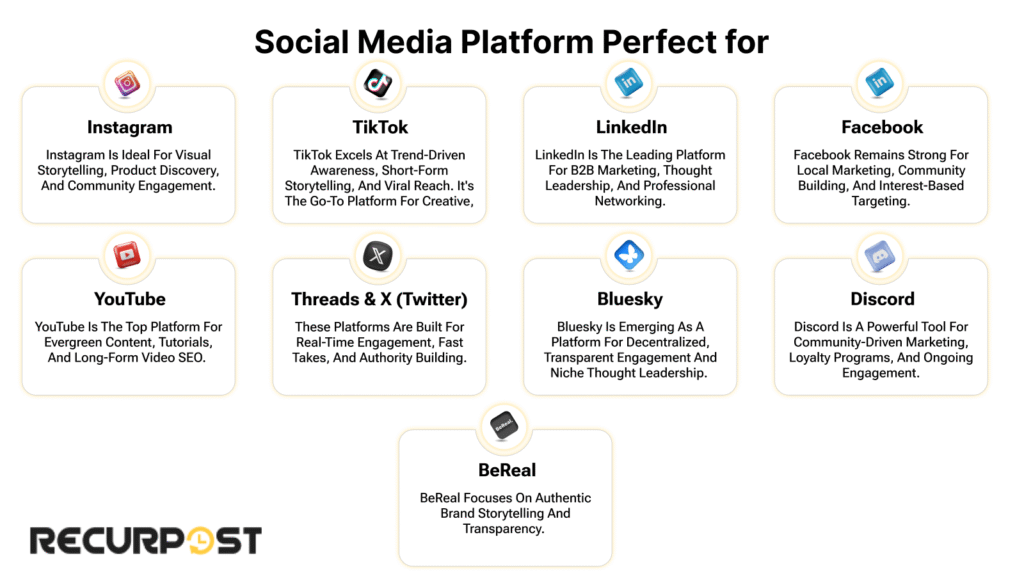
Marketing your business on social media platforms requires applying your social media marketing strategy on platforms where your audience engages, which allows companies to reach customers through targeted content, strategic posting schedules, and community-building activities. Each platform has unique audiences, content formats, and reward behaviors, making copy-paste posting ineffective.
How to approach each major and emerging platform in 2025:
Instagram: Reels, Product Tags, and Community
Instagram leads platforms for engagement and e-commerce in 2025.
What works now:
- Reels with sharp hooks and captions under 15 seconds (optimal video length = more engagement)
- Product tags and shoppable posts
- Interactive Stories (polls, quizzes, Q&As) to increase community involvement
- UGC and behind-the-scenes clips that build trust
Starter move: Create a weekly Reels series with value-driven or product-focused content. Use Instagram Insights to find the best times to post.
TikTok: Raw Creativity Meets AI Trends
TikTok drives trends and discovery through short-form video.
What works now:
- Short-form AI-generated or enhanced videos (7–15 seconds)
- Trending sounds with a personal twist
- Micro-educational tips and day-in-the-life content
- Relatable, authentic storytelling over polished production
Starter move: Post 3 videos a week. Test different styles, funny, educational, or user-driven, and track what sticks.
LinkedIn: Thought Leadership Meets Real Talk
LinkedIn functions as a content and networking hub for professionals and creators.
What works now:
- Behind-the-scenes or personal growth stories
- Native carousels, documents, and short-form videos
- Story-driven posts with a personal tone and learnings
- Hashtag use: 3–5 relevant tags per post
Starter move: Share a weekly reflection, tip, or case study. Don’t be afraid to be human — that’s what earns engagement.
Facebook: Niche Communities and Local Power
Facebook remains strong for local marketing, events, and interest-based communities.
What works now:
- Local business promotions with Events and targeted Ads
- Running or joining niche Facebook Groups
- UGC and real reviews
- Facebook Live Q&As or product drops
Starter move: Launch a Facebook Group around your business niche. Post value-driven content and prompt discussions regularly.
YouTube: Authority and Evergreen Search
YouTube excels in long-form, searchable content and now short-form videos.
What works now:
- YouTube Shorts (under 60 seconds) are algorithm darlings
- Tutorials, reviews, and expert explainers
- Keyword-optimized titles, tags, and descriptions
- Organized playlists for binge-friendly content
Starter move: Repurpose your TikToks or Reels into Shorts. Optimize titles like “How to Bake Sourdough in 2025” for search.
Threads & X (Twitter): Fast Takes and Authority Building
Perfect for brands and creators who thrive on conversation and commentary.
What works now:
- Quick how-tos, commentary on trends
- Consistent daily posts (1–2 per day)
- Mini-threads or insights in plain text
- Community engagement through replies and retweets
Starter move: Start a “Tip of the Day” series with one-sentence insights. Engage meaningfully with responses.
Bluesky: Rising Star in Decentralized Social
Bluesky has surged from 13 million users in late 2024 to 26 million in early 2025, and is attracting creators, developers, and open internet advocates.
What works now:
- Clean, conversation-first posts
- Community-driven discussions
- Ideal for niche brands or early adopters
- Credibility, transparency, and authenticity win
Starter move: Start sharing behind-the-scenes content and thought pieces on industry topics. Think less viral, more value.
Discord: Community-Led Brand Ecosystems
Discord isn’t just for gamers anymore. It’s becoming a go-to hub for deep community building and ongoing engagement.
What works now:
- Invite-only groups for loyal customers
- Channels dedicated to support, tips, or feedback
- Exclusive drops, polls, and voice chats
- Ideal for education brands, creators, and tech startups
Starter move: Launch a small, invite-only Discord server around your niche. Create channels for learning, updates, and casual chat.
BeReal: Authenticity-First Storytelling
BeReal champions raw, unfiltered moments — and that’s exactly what many audiences are craving.
What works now:
- In-the-moment photos from teams and users
- Human-centered storytelling without polish
- Great for brands prioritizing transparency and personality
Starter move: Start using BeReal to document real-time product use, team culture, or customer experiences. Think of it as a “brand diary.”
Using platforms the right way in 2025 means embracing their strengths and their audiences. The goal isn’t to be on all of them. It’s to be great on 1–2 that align with your goals.
Trends to Watch for Social Media Marketing in 2025
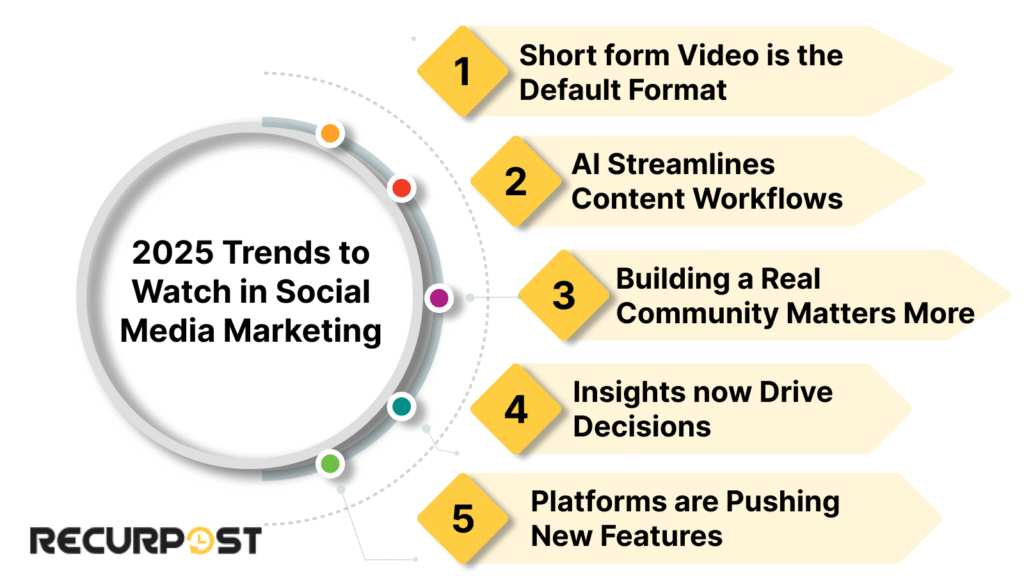
These trends define social media marketing success in 2025.
Short Form Video Is the Default Format
Reels, TikToks, and Shorts drive more engagement than static content across social platforms.
What this means:
- Videos under 30 seconds perform best
- Strong hooks in the first 3 seconds are essential
- Add captions—many users scroll with sound off
Short videos help increase brand awareness and create engaging content that stands out in fast-moving feeds.
AI Streamlines Content Workflows
AI integrates into social media marketing through tools and platform features.
Marketers use AI tools like RecurPost, Canva AI, and ChatGPT to:
- Plan posts in bulk using a content calendar
- Write captions that match your brand voice
- Repurpose old posts that performed well
- Save time on replies and scheduling
AI supports your marketing strategies, but you still need to guide it with a clear voice and goals.
Insights Now Drive Decisions
Audience behavior shifts rapidly, making data-driven decisions necessary for effectiveness.
Track:
- What time are your followers most active
- Which content formats drive the most actions
- How people move from posts to clicks or messages
Use tools like RecurPost analytics, native platform insights, and Google Analytics to measure success and gather valuable insights.
These insights shape everything from post timing to campaign budgets.
Building a Real Community Matters More
Brands with a real social presence outperform those chasing followers.
Focus on:
- Consistent replies in comments and DMs
- Stories with polls and questions
- Sharing user-generated content (UGC) with credit
This improves customer engagement and keeps people returning to your page. It also helps with social media listening, so you understand what your audience says and wants from your brand.
Platforms Are Pushing New Features
Each network updates its algorithm and tools often. Using new features early gives you better reach.
What’s new in 2025:
- Instagram: Reels with product tags, exclusive stories for close followers
- TikTok: Search-driven shopping and creator monetization tools
- LinkedIn: AI-based summaries and resume boosters
- Threads: Polls and visual replies
- Facebook: Groups and Marketplace integration for local targeting
Staying updated helps with competitive analysis. If your rivals use new tools and you don’t, they’ll get seen more, plain and simple. Use these trends to sharpen your social media content strategy, reach more people, and connect in ways that feel current.
Best Tools & Resources for Social Media Marketing in 2025
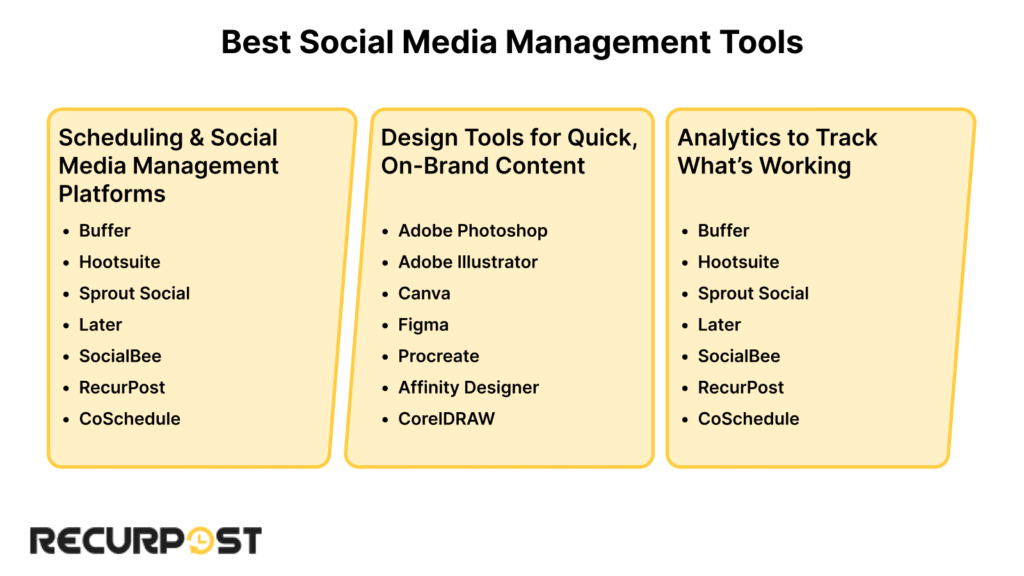
Tools should support your online marketing from strategy to execution.
These tools will help you hit your business goals and manage your content efficiently, whether you’re new to social media or keeping up with trends.
Scheduling & Social Media Management Platforms
Social media management platforms maintain visibility consistently, help you hit business goals, manage content efficiently, and maintain a consistent posting rhythm.
Top tools:
- RecurPost: Ideal for solo creators and small teams. Helps you build a reliable social media content calendar, recycle evergreen posts, and maintain a consistent voice across all platforms.
- Buffer: Simple scheduling for multiple social networks in one place.
- Hootsuite: Great if you’re handling several accounts and need team collaboration features.
Use these to support your smart social media goals, like posting three times a week or increasing reach by 20% in a month.
Design Tools for Quick, On-Brand Content
Strong visuals help your posts stand out in crowded feeds. These tools help you create branded graphics fast.
Top picks:
- Canva: Packed with templates for Stories, Reels, and carousels. Good for people with no design background.
- Adobe Express: Helps with both static and video formats. Great for making ad creatives quickly.
Use these tools to keep your brand voice clear and your posts visually aligned with your marketing goals.
Analytics to Track What’s Working
Data tells you what to keep doing and what to stop. Without it, you’re just guessing.
Track metrics like:
- Post reach and impressions
- Click-through rates
- Saves, shares, and comments
- Website traffic from social
Tools to use:
- RecurPost Analytics for performance across platforms
- Native insights (e.g., Instagram Insights, LinkedIn Analytics)
- Google Analytics for deeper conversion tracking
These tools help you measure success and make smarter decisions about your digital marketing.
Learning Resources for Beginners
Social media changes fast. Ongoing learning helps you stay current and confident.
Useful resources:
- RecurPost Blog: Focused on practical tips, examples, and templates for beginners.
- Meta Blueprint: Official tutorials for Facebook and Instagram.
- Google Digital Garage: Great for foundational educational content on online marketing and SEO.
These are especially useful if you’re new to the space and need structured guidance.
The right tools give structure to your marketing strategies, reduce overwhelm, and help you create better content in less time. They make daily posting easier—and help turn followers into real results.
Common Social Media Marketing Mistakes to Avoid in 2025
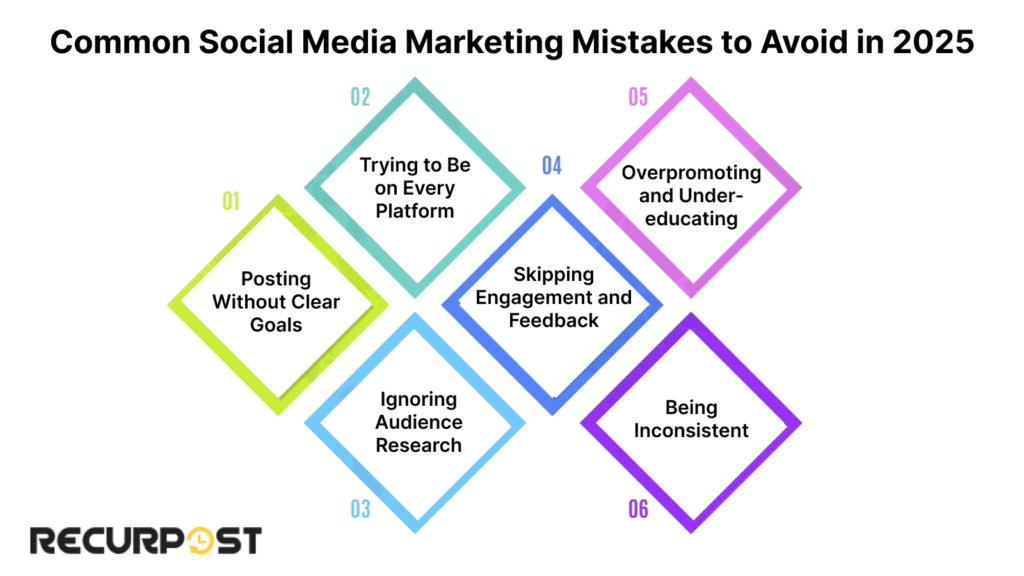
To establish a genuine social presence, avoid these common mistakes that hinder progress or confuse your audience.
Posting Without Clear Goals
Just sharing random social media posts won’t grow your business. Every post should support your marketing goals, whether it’s increasing engagement, driving traffic, or collecting leads.
Before you hit publish, ask:
“What’s the purpose of this post?”
Tie every piece of content back to your social marketing strategy.
Trying to Be on Every Platform
Not all social media networks are right for your business. Each platform has a different style, pace, and user base.
Instead of spreading yourself thin across different platforms, choose one or two where your audience is already active. Focus on doing those well.
Example: A coach helping Gen Z entrepreneurs should prioritize TikTok and Instagram, not Facebook and Twitter.
Ignoring Audience Research
Guessing what your audience wants is risky. Use data to shape your marketing strategies.
Conduct regular audience research to learn:
- What topics do they care about
- When they’re online
- Which formats do they prefer (video, carousel, polls)
- Where do they engage the most
The more you know, the better you’ll connect.
Skipping Engagement and Feedback
Posting without interaction misses the fundamental purpose of social media.
Engagement is how you build meaningful connections and gain trust. When people comment or message you, respond. Ask questions in your captions. Use polls to gather feedback.
Social media is a conversation, not a broadcast.
Overpromoting and Under-educating
Apply the 80/20 rule to avoid excessive promotion:
80% value (tips, stories, Q&A), 20% promotion.
Position yourself as a source of thought leadership. Share tips, explain your process, or show client results.
People don’t follow brands to be sold to. They follow brands that help them.
Being Inconsistent
Inconsistent posting causes algorithms and audiences to forget your brand.
Create a posting plan with a social media content calendar. Even if you post just twice a week, showing up consistently builds familiarity and authority.
Avoiding these mistakes helps you build stronger connections, improve your reach, and create content that supports real business results.
Conclusion: Social Media Marketing Is Your Most Powerful Tool in 2025
Social media marketing in 2025 builds trust, maintains visibility, and converts attention into action, connecting businesses with audiences across all budget sizes.
With short-form video, AI tools, community-driven content, and platforms built for growth, you don’t need a big team, just a smart plan. In a world where visibility equals trust, showing up online is the first step to winning offline.
FAQ: Social Media Marketing for Beginners in 2025
1. Do I need to be on every platform to grow?
No. Start with 1–2 platforms where your audience already spends time. Each social platform offers different strengths, but you don’t need all of them. Focus on where you can be consistent and create content that fits.
2. What kind of content should I post first?
Start with simple, value-based content:
-Tips related to your product or service
-Behind the scenes of your work
-Polls or Q&As to gather feedback
These help build trust and spark meaningful connections.
3. How often should I post as a beginner?
2–3 times a week is a solid start. What matters more is consistency. A regular posting schedule builds a strong social media presence over time.
4. What tools should I use to stay organized?
Use tools like:
–RecurPost for scheduling and content recycling
-Canva for design
-Google Docs or Notion for planning your calendar
Platform analytics + RecurPost to track what’s working
5. Is short-form video really necessary?
Yes. Short-form video gets higher reach and engagement across most platforms in 2025. It’s the best way to grab attention fast, especially on Instagram, TikTok, and YouTube Shorts.
6. How do I know what my audience wants?
Use social media listening and basic analytics. Watch for:
-Which posts get saves, comments, or shares
-What questions do people ask in comments or DMs
-Feedback from polls, quizzes, and reactions
This is key to adjusting your marketing strategies and posting content your audience wants.
7. How do I grow without ads?
You grow by:
-Posting consistently
-Sharing educational content
-Responding to DMs and comments
-Using Stories, Reels, and community tools
-Listening, adjusting, and staying present
Building a brand organically takes time, but it leads to deeper trust and more loyal followers.

Fenil Patel is a content writer specializing in social media marketing. He creates engaging, results-driven content that helps brands grow online, connect with audiences, and boost digital visibility. With a sharp eye for trends and strategy, he turns ideas into content that performs. Fenil is passionate about helping businesses stand out in the fast-paced world of digital marketing.
